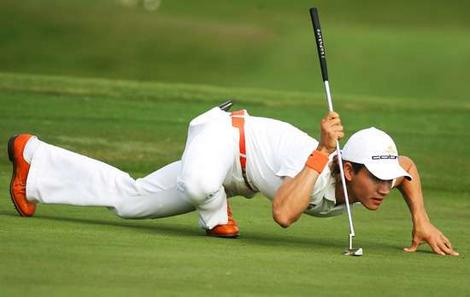Have you ever thought about how the grass is growing on the green?
Then you shouldn’t be surprised when the lengths of your putts are way off.
Shoot Low Scores
Have More Fun
Sign up for our free email newsletter (Good at Golf Academy). It is jam-packed with the best golf instruction insights: Including “Road to Scratch“, “Long Drive Champion Secrets“, “Consistency Blueprints“ and “The Big Lesson From the Lesson Tee“.
[mailpoet_form id=”3″]Yes, it’s completely free.
Join hundreds of other happy golfers or read more about what’s inside
Let’s take a closer look. Being able to read greens properly is key to good putting.
The grain of each green is the main reason for balls rolling really fast and considerably slower on the same green. Moreover it’s a reason for drastically different breaks on the same green.
Most Golfers don’t know how massively the grain influences the speed of greens.[clearboth]
Grass isn’t grass
A Golfer finds different kinds of grass on the golf course all over the world depending on different weather and temperature conditions.
On courses in cooler regions you can usually find bent grass which is particularly soft and flexible. In warmer regions you’ll most likely be confronted with bermuda grass which is hard and rigid.
When you are putting on bermuda grass against the grain your ball will be quite slow.
Whereas a putt with the grain can be compared with a billiard table.
That’s the main reason why a putt in one direction can be way to long while in the other direction it suddenly falls way too short. This effect gets even stronger because golf-architects usually like to sow their grass growing downhill.
Thus making downhill putts really fast.
How to Read Greens
If you want to learn to cope with different grains you first of all have to be able to recognize and assess the direction of the grain.
First of all harder grass has a bigger effect on putting than soft grass.
Then it’s good to know that grass is usually growing in the direction of water, a hill and usually growing downhill.
But you can see the grain too if you look for it: Stand in the middle of a green and look down in a 45 degree angle.
No turn and see how the brightness of the green changes.
With a little practice you will notice where the grass is the brightest and how it is the darkest in the exact opposite direction. That’s because the back of the culms reflect the light (bright) making the grass appear brighter.
The rule is easy: bright equals fast, dark equals slow.
Simple Exercise to Learn Reading Greens
To get a feeling for different grains try putting uphill diagonally against the grain.
Then try putting downhill diagonally with the grain. Putting diagonally will give you a better feel.
Start with putting into a defined area (e.g. stick some tees into the ground) and watch how each putt behaves. Then try the same with some golf holes.



Leave a Reply